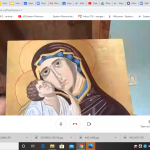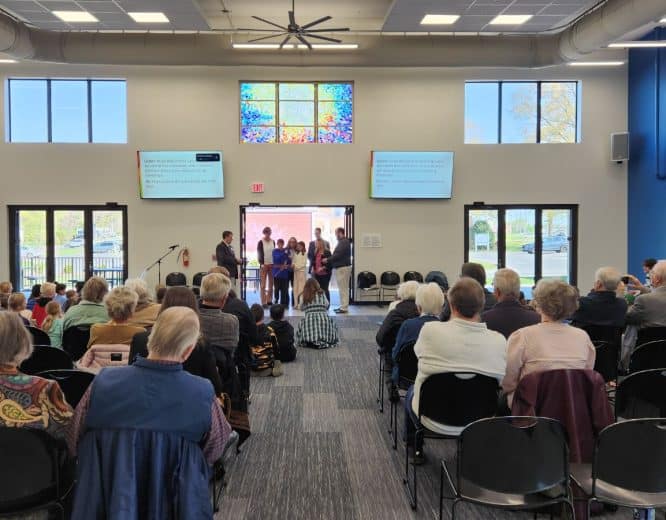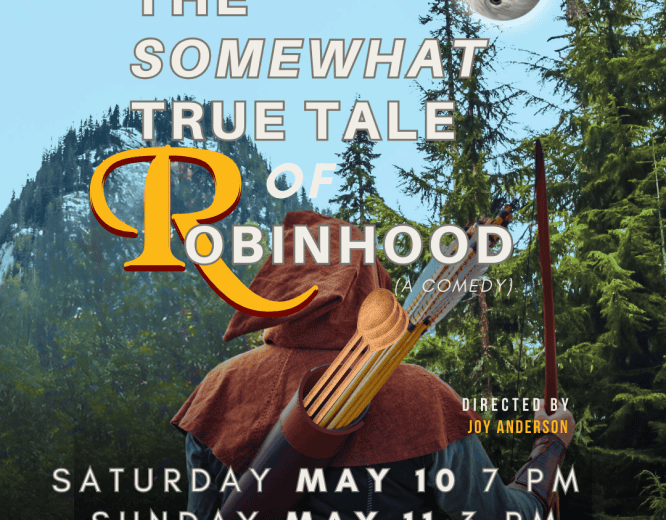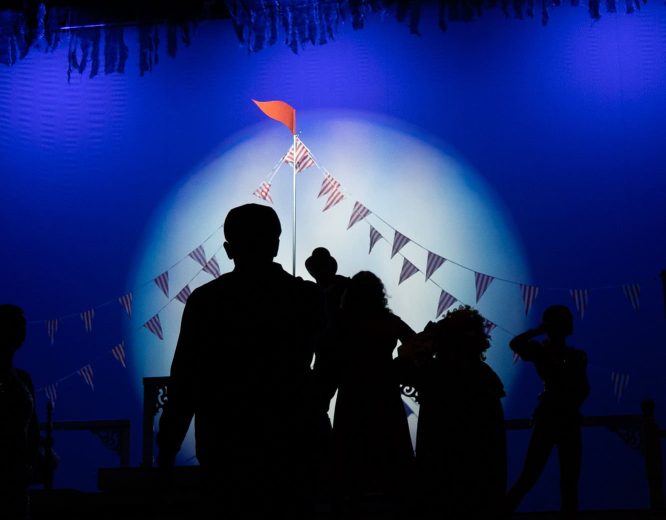Icon Replica Brings Global Christianity to Life
Fiona Mitchell researched the history of religious icons and painted a replica of an Eastern Orthodox icon for the Honors Global Christianity class taught by Elwood Yoder. She presented her research and painting via Google Meet to the class during the COVID’19 shut down, spring 2020.
Fiona painted the replica on wood using metallic paint to “try to capture the light” without the gold leaf paint that was use on the original paintings. An unexpected part of the project, says Fiona, was learning about extended family members through conversations with her parents during the project. Fiona plans to give the painting to her father, Peter Mitchell, class of ’84 and pastor of All Souls Anglican Church in Woodstock, Virginia.
Eastern Orthodox Iconography
by Fiona Mitchell ’22
The word icon means “image,” but in the Christian tradition, icons are not used to represent just any image, but one with religious meaning (“Icons: the Orthodox”). In the Eastern Orthodox Church, Oriental Orthodoxy, Roman Catholicism, and certain Eastern Catholic churches, icons are a way of representing religious content and subjects, with much meaning behind them (“Icon”). Most often icons are used to show a depiction of Christ, the Mother of God, a saint, or something that had happened in the church’s history (“Icons: the Orthodox”). Icons can be carved, embroidered, printed, or painted on wood (“Icon”). They take their form in paintings, mosaics, enamels, or miniatures, but there are some where this is not the case (“What is an Icon”). What makes a piece of art an icon is not the painting’s style, but the subject, meaning and uses for it, or intentions behind the artist who painted it (“What is an Icon”).
According to an 8th century church tradition, Luke the Evangelist was the first iconographer. But four centuries earlier, there are records of the earliest images treated as icons made by Aelius Lampridius (“Icon”). In the 4th century, some churches were very much against this. At the Spanish Non-ecumenical Synod of Elvira, the bishops said: “Pictures are not to be placed in churches so that they do not become objects of worship and adoration”(“Icon”). After Constantine the Great came into power (ca. 280-377) and Christianity was legalized, Christian art was bring produced on a very large scale (“Icons: the Orthodox”). These pieces of art were not yet considered icons, but set a foundation for the art that would become icons in the centuries to come.
When Constantina (Emperor Constantine’s sister) asked Eusebius for an icon of Jesus, he refused her by saying: “To depict purely the human form of Christ before its transformation…is to break the commandment of God and to fall into pagan error” (“Icon”). Having taken this position, Eusebius was called the father of iconoclasm(“Icon”). When Constantine converted to Christianity a majority of his subjects continued to live their lives as pagans (“Icon”). The Roman imperial cult decided that the tradition of burning candles and offering incense to the emperor’s image was acceptable because it would have been politically wrong to try to suppress it (“Icon”). So, in the 5th century, they still honored the reigning emperor in such ways (“Icon”). In 425 A.D., a Christian named Philostorgius charged all Orthodox Christians in Constantinople with idolatry because of their continued honoring of the emperor’s image (“Icon”). This occurred before references were found of honoring an image of Christ (“Icon”). It is likely that the act of revering of the emperor’s image was taken by Christians and incorporated into the worship of the God through the various depictions of Christ and the other Persons of the Trinity (“Icon”).
The Iconoclastic period began by the first iconoclastic, Emperor Leo III. (ca. 675–741). Iconoclasts were people in the 8-9th centuries who rejected icons mainly because the Old Testament taught against worshiping images (“The Editors”). Emperor Leo III issued many edicts that prohibited the use of images. People that supported the icons were called “Iconophiles” or lovers of images (“Icons: the Orthodox”).
The theology of icons was eventually accepted as the standard Orthodox position at the Seventh Ecumenical Council (787) (“Icons: the Orthodox”). The bishops said that reverencing the icons, such as bowing in front of them, showed respect for God. Thus icons were seen as transcending mere objects and representing the Person of Christ (“Icons: the Orthodox”).
Some of the most famous icons created are still used in worship today. One of them is called “Our Lady of Vladimir.” This icon is a representation of the Virgin Mary with baby Jesus being held in her arms. In 1395 the Prince of Moscow took the icon to his city. He wanted God to show mercy on the Muscovites, rescuing them from the Asian conqueror, Tamerlane (“Yegorov, Oleg”). Although Tamerlane’s army could have overthrown them, he did not, and the Muscovites credited their prayers to “Our Lady of Vladimir” as the reason for his change of mind (“Yegorov, Oleg”). Today the icon is found at the St. Nicholas Church, Moscow.
Another Symbolic icon is “The Trinity” by Andrei Rublev (“Yegorov, Oleg”). This was made in the 15th century and is also called “The Hospitality of Abraham” (“Yegorov, Oleg”). The icon is of three angels (according to the Genesis account) that went to Abrahams’s house. The angels symbolize the Father, Son, and Holy Spirit (“Yegorov, Oleg”). Today it is in the State Tretyakov Gallery, Moscow (“Yegorov, Oleg”). These are just two of the many important icons that are priceless to the Eastern Church and have greatly impacted Christianity.
If anyone wants to make a good icon, the icon must be made using ancient techniques. In the past, backgrounds for icons were made using silver or gold leaf, but because this was expensive, paint was commonly used as a substitute (“Techniques”). The wood that was typically painted on was linen or pine, and had a cloth soaked in glue laid over it (“Techniques”). On top of this, the ground is laid with many layers of chalk mixed with fish glue. The outline is drawn with a needlepoint (“Techniques”). For the paints; water, egg yolk, and mineral pigments are mixed together to make various colors and thicknesses. To create the effect of luminosity, dark and light paints are piled on top of one another (“Techniques”). After the icon is finished, boiled linseed oil is put on top to preserve and prevent scratches while it also gives it a darker tone (“Techniques”).
Works Cited
“Icon Painting Workshops. School of Byzantine Iconography.” Byzantine Iconography – Murals,
web.archive.org/web/20110515130511/www.ikonograph.com/murals.html.
“Icons: the Orthodox Understanding of Images and the Influence on Western Art Icons.” EGO,
ieg-ego.e/en/threads/european-media/media-of-religious-transfer/davor-dzalto-icons/view
“Icon.” Wikipedia, Wikimedia Foundation, 7 Apr. 2020,
https://en.wikipedia.org/wiki/Icon
“Techniques of Icon Painting.” The Museum of Russian Art, 30 Oct. 2015,
tmora.org/currentexhibitions/online-exhibitions/transcendent-art-icons-from-yaroslavl-rus
sia/introduction-yaroslavl-city-of-the-bear/techniques-of-icon-painting/.
The Editors of Encyclopaedia Britannica. “Iconoclastic Controversy.” Encyclopædia Britannica,
Encyclopædia Britannica, Inc., 15 Aug. 2016,
www.britannica.com/event/Iconoclastic-Controversy.
“What Is an Icon ?”,
www.orthodoxa.org/GB/orthodoxy/iconography/whatisaniconGB.htm.gorov, Oleg. “5 Most Famous and Miraculous Icons That Russians Venerate.” Russia Beyond,
12 Nov. 2018, www.rbth.com/arts/329479-most-important-russian-icons.




